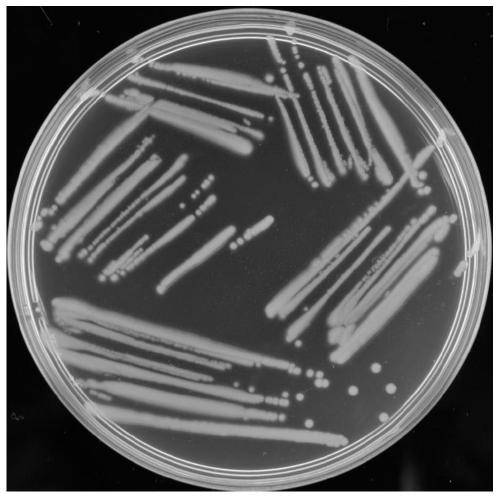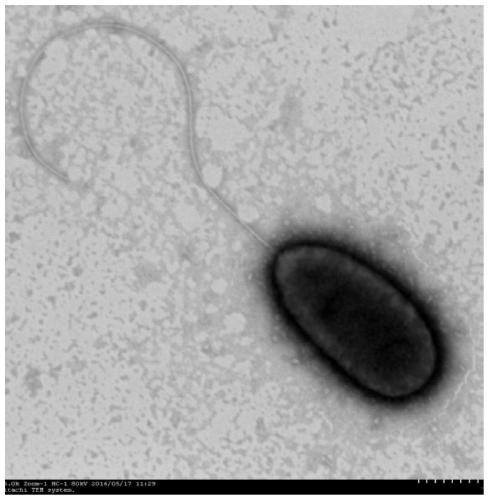A Nitroreductor Pseudomonas and its Application in Degrading Quorum Sensing Signaling Molecule DSF
A quorum sensing signal, Pseudomonas technology, applied in the direction of microorganism-based methods, bacteria, chemicals for biological control, etc., can solve the problem of small number of degradable DSF strains, achieve significant biodegradation effect, reduce The problem of pesticide abuse, the effect of good biocontrol effect
- Summary
- Abstract
- Description
- Claims
- Application Information
AI Technical Summary
Problems solved by technology
Method used
Image
Examples
Embodiment 1
[0046] Example 1 Acquisition and identification of Pseudomonas nitroreductor strain HS-18
[0047] 1. Isolation and screening of strain HS-18
[0048] (1) Soil sample collection: collected from long-term oil polluted soil as a microbial source.
[0049] Soil samples were collected on February 9, 2014 from the soil contaminated by food oil for a long time near South China Agricultural University in Guangzhou City, Guangdong Province. The soil from the surface to the depth of 5cm was sampled, bagged, and stored as a microbial source and brought back to the school for strains separate.
[0050] (2) Prepare culture medium: use DSF as the only carbon source, prepare LB medium and liquid MM inorganic salt medium and solid MM inorganic salt medium containing 0.5mMDSF without any other carbon source, use hydrochloric acid and sodium hydroxide Adjust the pH to 7.0, and sterilize at 121°C for 20 minutes.
[0051] Wherein, the inorganic composition and concentration of MM inorganic sa...
Embodiment 2
[0066] Antibiotic susceptibility analysis of embodiment 2 bacterial strain HS-18
[0067] In order to better study the biocontrol potential of the bacterial strain HS-18 obtained in Example 1, we conducted in-depth research on the biological characteristics of the bacterial strain HS-18.
[0068] The sensitivity of the strain HS-18 to different antibiotics was experimentally studied, as Figure 5 shown.
[0069] The experimental results show that the strain HS-18 has strong resistance to ampicillin (amp), chloramphenicol (cm), carbenicillin (carb), streptomycin (str), etc., and the resistance range reaches 200 μg ·mL -1 above; more sensitive to gentamicin (gen), kanamycin (kan), etc., and the resistance range is less than 10 μg·mL -1 .
Embodiment 3
[0070] Degradability determination of embodiment 3 bacterial strain HS-18 to DSF
[0071] 1. Strain cultivation and sample collection: Streak the strain HS-18 on the LB solid medium plate and cultivate overnight at 30°C. Pick a single colony, culture it with LB liquid medium overnight, as the seed solution, and inoculate it in the MM inorganic salt medium with 0.5mM DSF as the only carbon source at an inoculum size of 1:100, keep the temperature at 30°C and 150rpm Incubate in a shaker for 24 hours.
[0072] Samples collected at different time points were tested as follows:
[0073] First use a UV spectrophotometer (NANODROP) to measure the absorbance value at a wavelength of 600nm to indicate the growth of microorganisms; then add ethyl acetate to another sample for extraction, take the upper organic phase, repeat twice, and combine the extracts After rotary evaporation to dryness, dilute to 500 μL with methanol (HPLC pure) and place in a high-performance liquid chromatograp...
PUM
 Login to View More
Login to View More Abstract
Description
Claims
Application Information
 Login to View More
Login to View More - R&D
- Intellectual Property
- Life Sciences
- Materials
- Tech Scout
- Unparalleled Data Quality
- Higher Quality Content
- 60% Fewer Hallucinations
Browse by: Latest US Patents, China's latest patents, Technical Efficacy Thesaurus, Application Domain, Technology Topic, Popular Technical Reports.
© 2025 PatSnap. All rights reserved.Legal|Privacy policy|Modern Slavery Act Transparency Statement|Sitemap|About US| Contact US: help@patsnap.com



